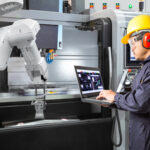In the manufacturing industry, deploying new technology involves significant investment. Every choice must be carefully considered to ensure it satisfies organization needs and can securely deploy with minimal disruption. Key is software — the selection of which involves choosing the right solutions to align with organization goals, processes, and technology infrastructure to deliver tangible benefits in three key areas: Digital transformation efforts, boosting safety, and mitigating risk.
By Al Letourneau • Product and marketing manager | Rockwell Automation
Paul Haikal • Commercial portfolio director | Rockwell Automation
Software selection and digital-transformation efforts
Digital transformation (DX) is foundational to modern manufacturing, and software selection plays an essential role in driving and enhancing this transformation. Historically, inadequate interoperability across incompatible technologies, including enterprise resource planning (ERP), supply chain management (SCM) manufacturing execution systems (MES), allied to disparate data types, has left data unleveraged.

Manufacturers should consider the unique needs of their manufacturing environment and select software that aligns with their business goals, to optimize competitive advantage and drive meaningful change throughout the organization.
Interoperability: Digital transformation involves disintegrating these incumbent silos and improving collaboration across departments. Dynamic manufacturing requires data flows from different components, systems, or technologies to work seamlessly together, usually from different vendors and on different standards. Here, software is key to enabling the interoperability and connectivity essential to complete and smooth integration between different systems and holistic views of the production process.
Software selection must therefore prioritize tools that facilitate communication, data sharing, and cross-functional collaboration among various devices, systems, and processes within a manufacturing environment. Open application programming interfaces (APIs) and standardized interfaces make it easier for different software applications to connect and interact. This allows manufacturers to mix and match software solutions from different vendors while ensuring they work together seamlessly. With that in place, production teams can establish and implement standardized agnostic communication protocols and data formats. These protocols ensure that information can be exchanged accurately and consistently between different components of the manufacturing process. This is important, as digital transformation relies heavily on data-driven decision making.

Software makes it possible to optimize and interconnect manufacturing processes. The best software also helps manufacturers boost plant safety … and in fact, some software can help manage technical, schedule, and commercial risks.
Insights and adaptability: Within digital transformation, software integrates physical machinery with digital systems for cyber-physical systems that can communicate and adapt in real time. This integration allows for advanced automation, monitoring, and control of manufacturing processes. Software enables data from these various sources to be integrated, with advanced analytics and data visualization capabilities applied to help manufacturers gain insights, identify trends, and make informed decisions to optimize production and drive innovation. Digital transformation also requires the ability to quickly adapt to changing market conditions and customer preferences. Therefore, software selection should focus on solutions that let manufacturers nimbly scale, modify processes, and introduce new products.
Software that allows for the creation of digital twins lets manufacturers create virtual representations of physical assets, processes, and systems for optimization. Such digital twins even let manufacturers virtually analyze workflow automation to find ways to streamline operations and boost efficiency.
Quality control: Selecting the right software can help ensure consistent product quality by implementing robust quality control processes. Through software selection, manufacturers can comply with industry standards, track defects, and manage corrective and preventive actions.
Software selection and industrial safety
The second area where software selection in manufacturing plays a crucial role is in ensuring industrial safety, providing tools and systems that help manage and mitigate potential risks and hazards. Manufacturing software should include modules or features for conducting risk assessments and managing risks associated with various processes and provide real time monitoring of equipment, processes, and environmental conditions.
Hazard monitoring: Software that powers potential hazards identification, likelihood and severity level and triggers alerts in case of deviations from expected norms or unsafe conditions is vital to preventing potential safety breaches and product loss. Having these measures in place enables manufacturers to proactively address safety concerns and implement measures to control or eliminate issues before they escalate to become significant.
Building on this, software can support continuous improvement initiatives by providing tools for root cause analysis, corrective actions, and performance tracking. By analyzing historical data and trends, manufacturers can identify patterns of safety incidents or near-misses, allowing them to take proactive corrective actions to prevent similar occurrences in the future. Furthermore, some software solutions include emergency response planning features, which allow manufacturers to develop and implement comprehensive plans for responding to safety incidents. These plans can include evacuation procedures, communication protocols and coordination with emergency services.
Safety training: Health and safety training and simulations are additional areas where software can be deployed to help manage employee training programs, providing a pathway for personnel to uplevel their skills and grow within an organization. This is a rapidly evolving area that can incorporate onsite and virtual training, track progress and record achievements. This ensures workers are adequately trained to operate machinery safely and follow proper safety protocols that are compliant with safety regulations and standards, reducing the risk of legal and regulatory issues.
Incorporating the safety lifecycle: Developments in global safety standards and technologies have made manufacturing safety a powerful tool to optimize production. Software is important in supporting the implementation of industrial safety standards and technologies, which can help improve risk management and reduce injuries. Software can also be used to incorporate the safety lifecycle into manufacturing operations to increase the effectiveness of machines while mitigating risks and decreasing operational and engineering costs.
The term safety lifecycle refers to a formalized engineering process that helps create a safety system that works effectively throughout its lifespan and is described by Intl. standards set by the Intl. Electrotechnical Commission (IEC). By standardizing the safety lifecycle, the IEC provides a benchmark for industries and companies that want to meet an acceptable occupational safety level.
The safety lifecycle can be thought of as a series of phases. Each phase is designed to maximize productivity while also improving safety for employees by identifying the necessary steps for assessing and mitigating risks. Software is essential at every phase to ensure process consistency and automation, comprehensive data gathering and quality, and standardized reporting.
Performing a risk assessment to identify hazards and estimate the risk associated with them is the first step. This assessment determines the needed performance level for safety functions. Based on that, manufacturers can then determine the functional safety system’s requirements to mitigate any identified risks. Once a system is determined, the architecture can then be selected, and the safety circuit design documented. The design is verified to meet all requirements, including software and programming, and then installed and validated to verify operation within defined parameters and compliance with standards. A safety system must be monitored and evaluated frequently. Regular verification ensures that the system requirements operate within specified parameters for production, and system upgrades and improvements can be made, as necessary.
Predictive maintenance: Software systems for maintenance planning and asset management assist in scheduling regular equipment inspections, maintenance, and repairs. Predictive maintenance helps ensure that equipment is well-maintained, using condition-monitoring tools and techniques and asset information to track equipment performance and next, to anticipate failure before it happens. This improves safety, reducing the likelihood of malfunctions or breakdowns that could lead to accidents.
Critical to success is knowing what products are run and when, the cost of all activities, and when maintenance was last performed, among other factors. There are several technologies that can help manage a predictive maintenance program, from ERPs to MES and computerized maintenance management system (CMMS) software. Software especially provides the means to drive predictive maintenance, leveraging data across Internet of Things (IoT) devices, the cloud, mobile applications, AI, and machine learning (ML) to analyze and predict insights and share entire operational data in one place. Monitoring machine sensors, predictive maintenance software can detect changes in the way assets are operating, and the software schedules maintenance and then notifies technicians of the newly scheduled task on their device of choice. The net benefit of predictive maintenance is that it keeps maintenance frequency low while reducing time spent on unplanned maintenance that can cause production delays.
Lockout and tagout procedures: So-called lockout/tagout procedures are used to ensure equipment is fully shut down, inoperable and isolated from all energy sources. It ensures employees stay safe from unexpected and potentially dangerous start-ups when equipment must be serviced or maintained. Keeping a manufacturing facility’s lockout/tagout procedures updated and accurate can be challenging, especially as facilities change equipment and staffing.
Software simplifies critical lockout/tagout management and compliance by digitizing these procedures to make them easier to access and manage. Digital lockout/tagout software tools provide authorized users with access to historical data, employee audits, procedural updates, and other features. Though some level of tagging like QR codes or RFID, employees can scan the equipment using a smartphone, tablet, or mobile device for instant access to audit procedures and related documentation. This confirms nothing ever gets lost, and employees always have the most up-to-date lockout/tagout procedures when needed. What’s more, digital lockout/tagout procedures give safety managers and other authorized users access to a dashboard containing data for equipment and employees. Having these software-driven processes in place ensures employees are kept out of harm’s way and the possibility of accidents is reduced.
Software selection and risk mitigation
Software selection can also support enterprises when it comes to risk mitigation. In this area, software selection delivers many of the benefits already discussed previously in this article, such as improving operational efficiency, data accuracy, compliance, safety and more. The following section looks at how careful consideration of a specific software platform, in this case, a visualization platform, can typically mitigate technical, schedule, and commercial risks.

Software enables digital transformations by serving as the foundation for process optimization and automation.
Technical or implementation risk: For manufacturers aiming to reduce technical risk, a user-friendly visualization platform for generating proprietary code is crucial, especially one that is easily deployable across various applications. When designing applications, integrators benefit from creating a library of tested, trusted proprietary code for specific purposes. This simplifies development and deployment, ensuring robust and proven modules can be confidently used. Furthermore, if customer support is needed at any point, the fact that developers are working with code that is used often, understood, well-documented and tested reduces support risk and promotes expedited resolution.
A collaborative visualization platform minimizes technical risk. By enabling multiple developers to collaborate, potential problems are caught earlier. Tools such as GitHub, shared repositories, and revision controls are essential for risk management. For example, without revision controls, two users might be able to concurrently edit the same part of an application … a scenario that wastes time and risks the introduction of errors. In contrast, revision controls let users immediately visualize and resolve conflicts. Having such controls embedded in the editor streamlines and protects the entire development process.
Reducing scheduling risk: Being able to reuse well-understood and well-tested pieces of code reduces development and deployment time and cost. Designing using standardized interfaces also enables information to be fed both from real time control systems and from one software component to another, and from there up to remote database servers and the cloud. Such field-proven modules of intellectual property speed deployment and reduce scheduling risks so design teams don’t need to “reinvent the wheel” every project.
Integrators and OEMs invest significantly in preparing proposals, seeking a reasonable certainty of winning business. Standardized, tested content provides flexibility and a competitive edge, mitigating commercial risks. Using familiar, well-understood components increases confidence in solution robustness and performance. Leveraging existing code lowers development costs and speeds up product delivery, while minor adjustments ensure customization for specific needs.

Software can drive manufacturing improvements by unifying manufacturing ecosystems and facilitating collaboration.
Reducing commercial risk: Consider for a moment the usefulness of universally applicable software — deployable on Windows or LINUX industrial systems. Where such software deploys to certain sealed human machine interface (HMI) appliances, it renders the latter an edge-computing component with features comparable to those of larger industrial PCs.
In fact, some such HMIs offer simple hardware and software but share a common deployment framework. This mitigates commercial risk, as OEMs and integrators can provide a given user experience minus the need for pricier hardware. HMIs are user-friendly and affordable, enhancing cost-effectiveness. Plus, HMIs aid in cybersecurity risk reduction. That’s because these components have a limited attack surface for simpler administration and better security than open-ended devices having exposed operating systems necessitating antivirus software.
You may also like:
Filed Under: DIGITAL TRANSFORMATION (DX)









